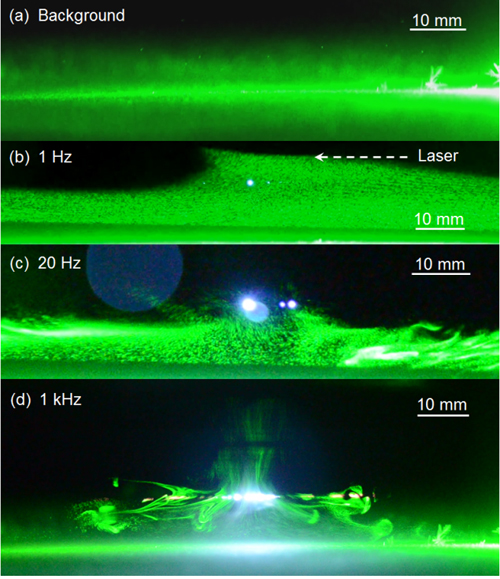Weather modification is always the dream of human beings. The aims focus on the prevention of disasters, such as damage caused by hail or flood, and drought. The traditional ways are to spray silver iodide or dry ice seed into cloud. In recent years laser filament-induced water condensation has been developed both in the experimental cloud chamber and atmospheric environment. Laser filaments can be created remotely, last for tens to hundreds of meters in the atmosphere and have also been demonstrated to be able to transmit through clouds or strong extended turbulence. Therefore, laser filaments are promising candidates for innovative applications as an alternative to the dispersion of particles in the clouds.
Up to now, experiments on laser-induced water condensation and precipitation were carried out mainly by using femtosecond laser filamentation. A question arises as to whether less powerful picosecond (ps) laser pulses without filamentation could induce condensation and precipitation. The joint China–Canada team investigated water condensation in a laboratory cloud chamber induced by picosecond (ps) laser pulses at ~350 ps (800 nm/1–1000 Hz) with a maximum peak power of ~25 MW. The peak power was much lower than the critical power for self-focusing in air (~ 3–10 GW depending on the pulse duration). They could not even induce optical breakdown in air at the focal region of a lens with a focal length of 30 cm. However, we found that by focusing such pulses into a cloud chamber, condensation and precipitation could still be obtained because of the explosion and breakdown of the background water and ice droplets by the laser pulses. These tiny particles would grow until precipitation in a super-saturation zone due to laser-induced airflow in a cold region with a large temperature gradient. These experimental results provide useful information for the application of laser-induced water condensation in the realistic atmosphere.
The study entitled “Picosecond laser-induced water condensation in a cloud chamber” has been published in Opt. Express (https://www.osapublishing.org/oe/abstract.cfm?uri=oe-24-18-20494).

Fig. 2. (a) Background before the launching of ps laser pulses; (b)–(d) Sparks induced by a single pulse with the energy of ~9.3 mJ (a), laser pulses at 20 Hz with the energy of ~10 mJ per pulse (b), and 1 kHz with the energy of ~8.9 mJ per pulse (c), respectively. The shooting conditions of the Nikon D7000 camera are f number (F)=3.2, shutter speed (S)=1/50 s, and light sensitivity (ISO)=400. (Image by SUN Haiyi)
This work was supported by the National Natural Science Foundation of China (11425418, 61475167, 11404354 and 61221064), Shanghai Science and Technology Talent Project (12XD1405200), and the State Key Laboratory Program of the Chinese Ministry of Science and Technology. T.-J Wang also acknowledges the support from 100 Talent Program of Chinese Academy of Science.
Key words: Ultrafast nonlinear optics; Meteorology; Laser-induced chemistry; Photoionization; Turbulence
Prof. LIU Jiansheng, Ph.D, Group leader
Shanghai Institute of Optics and Fine Mechanics, Chinese Academy of Sciences
(http://www.siom.ac.cn/)
Prof. LI Ruxin, Ph.D, Group leader
Shanghai Institute of Optics and Fine Mechanics, Chinese Academy of Sciences
(http://www.siom.ac.cn/)